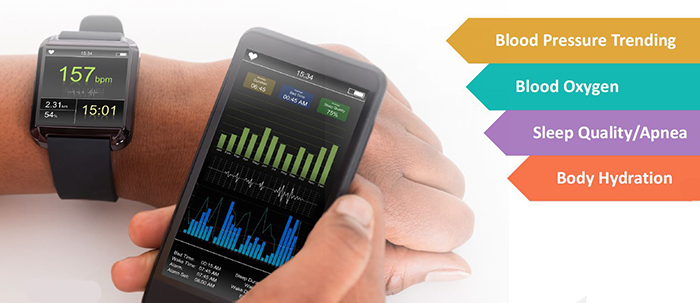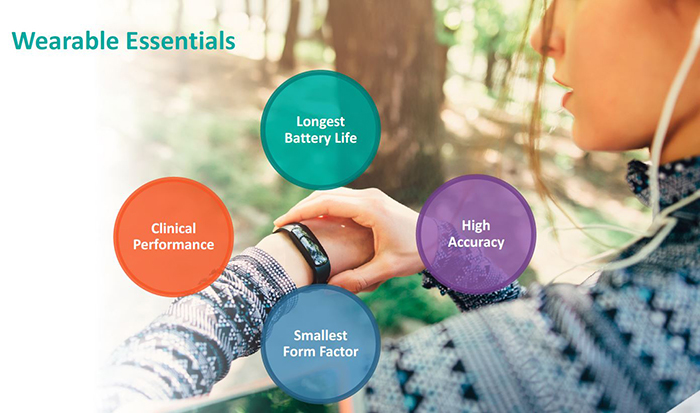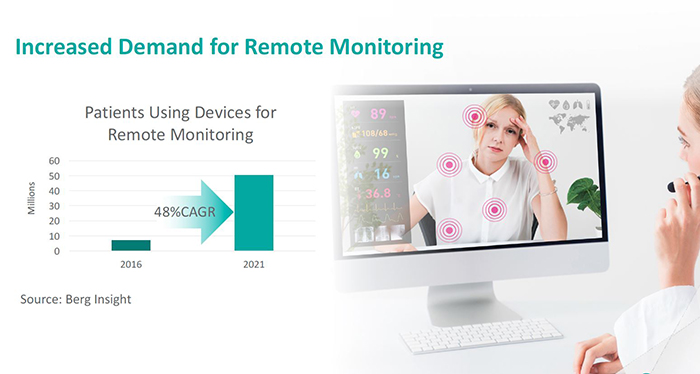Counting the cost of global healthcare
As Sui Shieh, VP, Industrial & Healthcare, Maxim Integrated, explains, technology is bringing the world of clinical monitoring and fitness monitoring closer together. The world is spending around $9tn a year on healthcare – to put that in perspective that’s ten percent of global GDP. This situation is even more acute in the US with estimates quoting that healthcare will account for around 20% of GDP within five years.
Not only are these very high numbers, they are growing at a very significant rate. In order to slow this growth down (let alone decrease the numbers), early detection and prevention is crucial. And particularly for people with chronic conditions that need to be monitored closely. Not only does this reduce cost but it leads to better outcomes.
“The mind-set of the consumer is shifting from a reactive to a more proactive approach to healthcare,” said Shieh. “A lot of people visit a doctor once a year to get a physical and some don’t even do that. Most people only visit a doctor when they get sick.
“However, an ounce of prevention is worth a pound of cure. For a lot of consumers the penny has dropped where this is concerned, and this has led to many people investing in a wearable fitness device over recent years.”
Valuable data
The information given out by many fitness devices however, is not all that useful in a clinical setting. Leading to an element of stagnation within that market over the last few years. For growth to return, the companies involved in this sector know that there must be some discernable value in the data they provide.
Shieh continued: “Two months ago the FDA in the US (the Food & Drug Administration) announced a pre-certify programme for digital health devices. More than 100 companies applied to be in this programme. And needless to say all these companies are rushing to add FDA approved features onto their devices.

“For people that have chronic conditions it’s very important to monitor their diet, exercise, medication etc. For two of the most common chronic conditions, heart disease and diabetes, there are already products on the market that will help them do that. In the US doctors can prescribe ECG patches and continuous glucose patches which are FDA certified and are payable via insurance. So the market for these type of products already exists today.”
Increased demand for remote monitoring
The number of people who are using devices for remote monitoring is growing rapidly – from around six million in 2016 to around 50 million by 2021. This is about 50% CAGR.
Not only does this allow patients to monitor their conditions more frequently than going to the doctor every few months, they also have access to the best doctors. For example, in rural areas of the US there is a shortage of doctors in general and particularly specialists. With remote monitoring devices these patients can have access to any specialist – potentially anywhere in the world.
Healthcare wearables essentials
Customers, first and foremost, are obviously looking for clinical performance from their healthcare wearables. That means designers must enable customers to achieve FDA certification. In order to do that a certain level of accuracy must be achieved. And, since we’re talking about wearable devices, it’s obvious that you also want to have long battery life and small size.
Accurate, continuous self-monitoring
Fitness and clinical wearables are started to converge a few years ago and Maxim has followed suit. Fitness devices are becoming more medical, with almost all fitness wearable companies trying to put more clinical features into their products. In many cases these features need to be FDA certified.
“On the clinical side are the more traditional companies, with much larger equipment. They are all trying to miniaturise that equipment into a wearable,” said Shieh. Therefore, the expertise of clinical-based companies combined with the miniaturisation skills of the fitness wearable companies, is creating a market for effective clinical wearables.

The requirements for both sets of customers is actually quite similar. Maxim have had a lot of success with fitness customers over the last few years, who are looking for devices that are small in size and low in power. With that experience, Maxim are putting those features into the clinical devices that will allow customers to achieve FDA certification.
Shieh added: “Size and power are very important to our customers. We have a long history of helping our customers in this regard and we have unique processes, technology and design expertise to make sure we can do this better than anyone else.”
A combined approach
“Our customers are asking us for blood pressure trending; blood oxygen; sleep quality/apnea; and body hydration. We have products in four different areas of health and wellbeing – bio-potential; optical; temperature and PMIC and we have recently launched two key offerings into the bio-potential and optical areas,” continued Shieh.
The MAX86140 and MAX86141 optical pulse oximeter/heart rate sensors and the MAX30001 electrocardiogram (ECG) and bioimpedance (BioZ) analogue front end (AFE) enables accurate monitoring of vital signs to monitor wellness/fitness and prevent health problems before they even begin.
Today’s continuous monitoring technology is shifting the consumer mindset away from a reactive monitoring approach to a proactive one. Rather than waiting for yearly doctor visits to get results for blood pressure and other vital signs, consumers want real-time information about the status of their health.

This shift is causing an increased demand for accurate, small, and low power wearable devices - an important enabler for this new way of thinking. As continuous monitoring and preventive healthcare become more common, both technology providers and health practitioners must embrace and accommodate these new demands to be successful. Before we know it we will be able to check our vital signs as easy as checking the news or weather. Shieh added: “We are increasing the demand for remote monitoring by making it easier to use, and providing information that in many cases is FDA certified, on devices that have long battery life and are small in size.”
Maxim’s portfolio of sensors for wearable health and fitness applications allows consumers to accurately monitor a variety of key vital signs while being mindful of low power (for longer battery life) and small size (for convenience and comfort).
The MAX86140 and MAX86141 can be used to measure PPG signals on the wrist, finger, and ear to detect heart rate, heart rate variability, and pulse oximetry. The MAX30001 measures ECG and BioZ on the chest and wrist to detect heart rate, respiration, and arrhythmias.
Shieh concluded: “Compared to competitive solutions, the MAX86140 and MAX86141 require less than half the power and is approximately one third smaller, while the MAX30001 requires approximately half the power in almost half the size. By collecting beat to beat data about the heart, these solutions collect accurate data so users can recognise important symptoms when they first begin. In addition, the MAX30001 meets IEC60601-2-47, clinical ECG standards.”











